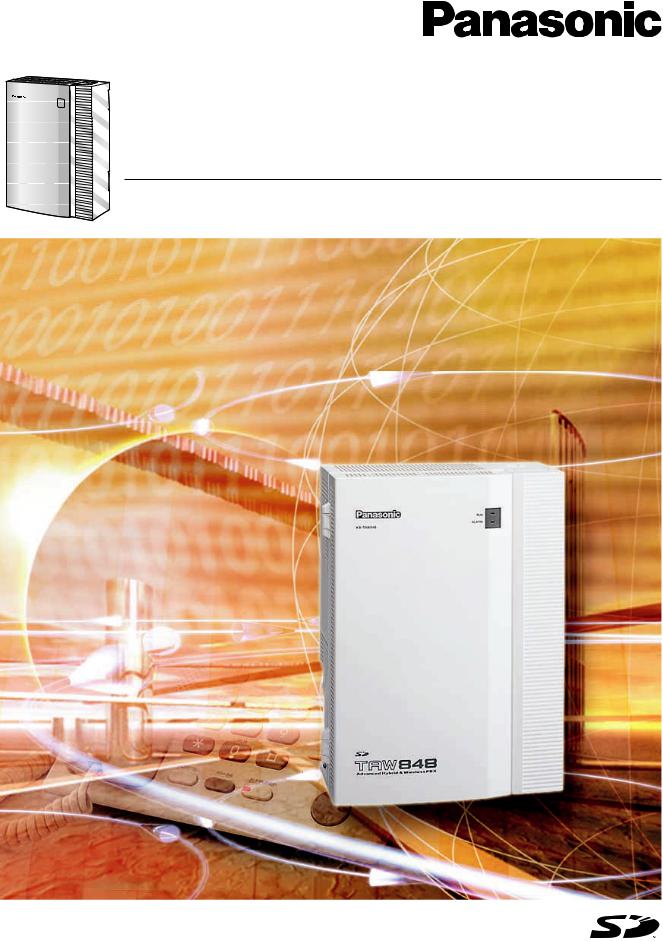Panasonic kx-taw848 Operation Manual

Advanced Hybrid & Wireless PBX
Installation Manual
Model No. KX-TAW848
Thank you for purchasing the Panasonic Advanced Hybrid & Wireless PBX, KX-TAW848.
Please read this manual carefully before using this product and save this manual for future use. SD Logo is a trademark.

System Components
System Components Table
|
Model |
Description |
|
|
|
Main Unit |
KX-TAW848 |
Main Unit |
|
|
|
CO Line Cards |
KX-TAW84880 |
4-Port Analog Trunk Card (LCOT4) |
|
KX-TAW84893 |
4-Port Caller ID Card (CID4) |
|
|
|
Extension Cards |
KX-TAW84870 |
4-Port Hybrid Extension Card (HLC4) |
|
KX-TAW84874 |
8-Port Single Line Telephone Extension Card (SLC8) |
|
KX-TAW84875 |
4-Port Proprietary Extension Card (PLC4) |
|
KX-TAW84876 |
8-Port Proprietary Extension Card (PLC8) |
|
|
|
Other Cards |
KX-TAW84861 |
4-Port Doorphone Card (DPH4) |
|
KX-TAW84866 |
8-Channel Echo Canceller Card (ECHO8) |
|
KX-TAW84868 |
Extension Caller ID Card (EXT-CID) |
|
KX-TAW84891 |
2-Channel Message Card (MSG2) |
|
KX-TAW84896 |
Remote Card (RMT) |
|
|
|
Cell Station (CS) |
KX-T0141 |
2-Channel Cell Station Unit for 2.4 GHz Portable Station |
|
|
|
Proprietary Equipment |
KX-T30865 |
Doorphone |
|
|
|
Available Proprietary Telephones
The PBX supports all of the Panasonic KX-T7000 and KX-TD7000 series:
•Analog proprietary telephones (e.g., KX-T7730)
•Portable stations (e.g., KX-TD7690)
•DSS consoles (e.g., KX-T7740)
Note
The PBX does not support the following telephones:
•Digital proprietary telephones
•KX-T30800 series Proprietary Telephones and DSS consoles
•KX-T61600 series Proprietary Telephones and DSS consoles
•KX-T123200 series Proprietary Telephones and DSS consoles
For the equipment (e.g., Headset*1) that can be connected to a particular telephone, refer to the telephone's manual.
For other equipment that can be connected to the PBX, refer to "1.2.2 System Connection Diagram".
*1 The KX-T7090 headset can be connected to the KX-T7000 and KX-T7300 series telephones.
2 Installation Manual

Abbreviations in this manual
Analog proprietary telephone: APT
Portable station: PS
Single line telephone: SLT
Notice
The power supply capacity of the PBX may differ from the values described in this manual depending on the model number. Please consult your dealer for detailed information.
Installation Manual |
3 |
|
|

Important Safety Instructions
SAFETY REQUIREMENTS
When using your telephone equipment, basic safety precautions should always be followed to reduce the risk of fire, electric shock and injury to persons, including the following:
1.Read and understand all instructions.
2.Follow all warnings and instructions marked on the product.
3.Unplug this product from the wall outlet before cleaning. Do not use liquid cleaners or aerosol cleaners. Use a damp cloth for cleaning.
4.Do not use this product near water, for example, near a bathtub, wash bowl, kitchen sink, or laundry tub, in a wet basement, or near a swimming pool.
5.Do not place this product on an unstable cart, stand, or table. The product may fall, causing serious damage to the product.
6.Slots and openings in the cabinet and the back or bottom are provided for ventilation; to protect it from overheating, these openings must not be blocked or covered. The openings should never be blocked by placing the product on a bed, sofa, rug, or other similar surface. This product should never be placed near or over a radiator or other heat source. This product should not be placed in a built-in installation unless proper ventilation is provided.
7.This product should be operated only from the type of power source indicated on the product label. If you are not sure of the type of power supply to your home, consult your dealer or local power company.
8.This product is equipped with a 3-wire grounding type plug, a plug having a third (grounding) pin. This plug will only fit into a grounding type power outlet. This is a safety feature. If you are unable to insert the plug into the outlet, contact your electrician to replace your obsolete outlet. Do not defeat the safety purpose of the grounding type plug.
9.Do not allow anything to rest on the power cord. Do not locate this product where the cord will be abused by people walking on it.
10.Do not overload wall outlets and extension cords as this can result in the risk of fire or electric shock.
11.Never push objects of any kind into this product through cabinet slots as they may touch dangerous voltage points or short out parts that could result in a risk of fire or electric shock. Never spill liquid of any kind on the product.
12.To reduce the risk of electric shock, do not disassemble this product, but take it to a qualified person when some service or repair work is required. Opening or removing covers may expose you to dangerous voltages or other risks. Incorrect reassembly can cause electric shock when the appliance is subsequently used.
13.Unplug this product from the wall outlet and refer servicing to qualified service personnel under the following conditions:
a)When the power supply cord or plug is damaged or frayed.
b)If liquid has been spilled into the product.
c)If the product has been exposed to rain or water.
d)If the product does not operate normally by following the operating instructions. Adjust only those controls that are covered by the operating instructions because improper adjustment of other controls may result in damage and will often require extensive work by a qualified technician to restore the product to normal operation.
e)If the product has been dropped or the cabinet has been damaged.
4 Installation Manual

f)If the product exhibits a distinct change in performance.
14.Avoid using a telephone (other than a cordless type) during an electrical storm. There may be a remote risk of electric shock from lightning.
15.Do not use the telephone to report a gas leak in the vicinity of the leak.
SAVE THESE INSTRUCTIONS
Installation Manual |
5 |
|
|

Precaution
|
|
WARNING |
|
|
|
DO |
|
NOT |
REMOVE |
||
SD |
MEMORY |
CARD |
|||
WHILE POWER |
IS |
||||
SUPPLIED |
TO |
THE |
|||
ADVANCED |
HYBRID & |
||||
WIRELESS |
|
|
PBX |
||
Doing so may cause the PBX to fail to start when trying to restart the system.
6 Installation Manual

•Keep the unit away from heating appliances and electrical noise generating devices such as fluorescent lamps, motors and televisions. These noise sources can interfere with the performance of the PBX.
•This unit should be kept free of dust, moisture, high temperature (more than 40 °C [104 °F]) and vibration, and should not be exposed to direct sunlight.
•Never attempt to insert wires, pins, etc. into the vents or other holes of this unit.
•If there is any trouble, disconnect the unit from the telephone line. Plug an SLT into the telephone line. If the telephone operates properly, do not reconnect the unit to the line until the trouble has been repaired by an authorized Panasonic Factory Service Center. If the telephone does not operate properly, chances are that the trouble is in the telephone network, and not in the PBX.
•Do not use benzene, thinner, or the like, or any abrasive powder to clean the cabinet. Wipe it with a soft cloth.
WARNING
•WHEN A FAILURE OCCURS WHICH EXPOSES ANY INTERNAL PARTS, DISCONNECT THE POWER SUPPLY CORD IMMEDIATELY AND RETURN THIS UNIT TO YOUR DEALER.
•DISCONNECT THE TELECOM CONNECTION BEFORE DISCONNECTING THE POWER CONNECTION PRIOR TO RELOCATING THE EQUIPMENT, AND RECONNECT THE POWER FIRST.
•THIS UNIT IS EQUIPPED WITH A GROUNDING CONTACT PLUG. FOR SAFETY REASONS, THIS PLUG MUST ONLY BE CONNECTED TO A GROUNDING CONTACT SOCKET WHICH HAS BEEN INSTALLED ACCORDING TO REGULATIONS.
•TO PREVENT THE RISK OF FIRE OR ELECTRIC SHOCK, DO NOT EXPOSE THIS PRODUCT TO RAIN OR MOISTURE.
•THE POWER SUPPLY CORD IS USED AS THE MAIN DISCONNECT DEVICE. ENSURE THAT THE SOCKET-OUTLET IS LOCATED/ INSTALLED NEAR THE EQUIPMENT AND IS EASILY ACCESSIBLE.
CAUTION
DANGER OF EXPLOSION EXISTS IF THE BATTERY IS INCORRECTLY REPLACED. REPLACE THE BATTERY WITH THE SAME OR EQUIVALENT TYPE RECOMMENDED BY THE BATTERY MANUFACTURER. DISPOSE OF USED BATTERIES ACCORDING TO THE MANUFACTURER’S INSTRUCTIONS.
Installation Manual |
7 |
|
|

When you ship the product
Carefully pack and send it prepaid, adequately insured and preferably in the original carton. Attach a postage-paid letter, detailing the symptom, to the outside of the carton. DO NOT send the product to the Executive or Regional Sales offices. They are NOT equipped to make repairs.
Product Service
Panasonic Factory Servicenters for this product are listed in the servicenter directory. Consult your dealer for detailed instructions.
The serial number of this product may be found on the label affixed to the side of the unit. You should note the model number and the serial number of this unit in the space provided and retain this book as a permanent record of your purchase to aid in identification in the event of theft.
MODEL No.:
SERIAL No.:
For your future reference
DATE OF PURCHASE
NAME OF DEALER
DEALER'S ADDRESS
DEALER'S TEL. NO.
8 Installation Manual

Introduction
This Installation Manual is designed to serve as an overall technical reference for the Panasonic Advanced Hybrid & Wireless PBX, KX-TAW848. It provides instructions for installing the hardware, and programming the PBX using the KX-TAW848 Maintenance Console.
The Structure of this Manual
This manual contains the following sections:
Section 1 System Outline
Provides general information on the PBX, including the system capacity and specifications.
Section 2 Installation
Describes the procedures to install the PBX. Detailed instructions for planning the installation site, installing the optional service cards, and cabling of peripheral equipment are provided. Further information on system expansion and peripheral equipment installation is included.
Section 3 Guide for the PC Programming Software
Explains the installation procedure, structure, and basic information of the KX-TAW848 Maintenance Console.
Section 4 Troubleshooting
Provides information on the PBX and telephone troubleshooting.
About the Other Manuals
Along with this Installation Manual, the following manuals are available:
Feature Guide
Describes all basic, optional and programmable features of the PBX, and step-by-step instruction for performing system programming using a proprietary telephone or a personal computer (PC).
User Manual
Provides operating instructions for end users using an APT, SLT, PS, or DSS Console.
Trademarks
•Microsoft and Windows are either registered trademarks or trademarks of Microsoft Corporation in the United States and/or other countries.
•Intel and Pentium are trademarks or registered trademarks of Intel Corporation or its subsidiaries in the United States and other countries.
•All other trademarks identified herein are the property of their respective owners.
•Screen shots reprinted with permission from Microsoft Corporation.
Installation Manual |
9 |
|
|

F.C.C. REQUIREMENTS AND RELEVANT INFORMATION
1.Notification to the Telephone Company
This equipment complies with Part 68 of the FCC rules and the requirements adopted by the ACTA. On the side of this equipment is a label that contains, among other information, a product identifier in the format US: ACJMF03AKX-TDA50. If requested, this number must be provided to the telephone company.
Installation must be performed by a qualified professional installer. If required, provide the telephone company with the following technical information:
•Telephone numbers to which the system will be connected
•Make: Panasonic
•Model: KX-TAW848
•Certification No.: found on the side of the unit
•Ringer Equivalence No.: 0.3A
•Facility Interface Code: 02LS2
•Service Order Code: 9.0F
•Required Network Interface Jack: RJ11
2.Ringer Equivalence Number (REN)
The REN is used to determine the number of devices that may be connected to a telephone line. Excessive RENs on a telephone line may result in the devices not ringing in response to an incoming call. In most, but not all areas, the sum of RENs should not exceed five (5.0). To be certain of the number of devices that may be connected to a line, as determined by the total RENs, contact the local telephone company. The REN for this product is part of the product identifier that has the format US: ACJMF03AKX-TDA50. The digits represented by 03 are the REN without a decimal point (e.g., 03 is a REN of 0.3). For earlier products, the REN is separately shown on the label.
3.Incidence of Harm to the Telephone Lines
If this equipment causes harm to the telephone network, the telephone company will notify you in advance that temporary discontinuance of service may be required. But if advance notice isn't practical, the telephone company will notify the customer as soon as possible. Also, you will be advised of your right to file a complaint with the FCC if you believe it is necessary.
4.Changes in Telephone Company Communications Facilities, Equipment, Operations and Procedures
The telephone company may make changes in its facilities, equipment, operations or procedures that could affect the operation of the equipment. If this happens the telephone company will provide advance notice in order for you to make necessary modifications to maintain uninterrupted service.
5.Trouble with this equipment
If trouble is experienced with this equipment, for repair or warranty information, please see the attached warranty, which includes the Servicenter Directory. If the equipment is causing harm to the telephone network, the telephone company may request that you disconnect the equipment until the problem is resolved.
6.Connection to Party Line
Connection to party line service is subject to state tariffs. Contact the state public utility commission, public service commission or corporation commission for information.
10 Installation Manual

7.Combined Use with Alarm Equipment
If your home has specially wired alarm equipment connected to the telephone line, ensure the installation of this equipment does not disable your alarm equipment. If you have questions about what will disable alarm equipment, consult your telephone company or a qualified installer.
Note
This equipment has been tested and found to comply with the limits for a Class B digital device, pursuant to Part 15 of the FCC Rules. These limits are designed to provide reasonable protection against harmful interference in a residential installation. This equipment generates, uses, and can radiate radio frequency energy and, if not installed and used in accordance with the instructions, may cause harmful interference to radio communications. However, there is no guarantee that interference will not occur in a particular installation. If this equipment does cause harmful interference to radio or television reception, which can be determined by turning the equipment off and on, the user is encouraged to try to correct the interference by one or more of the following measures:
•Reorient or relocate the receiving antenna.
•Increase the separation between the equipment and receiver.
•Connect the equipment into an outlet on a circuit different from that to which the receiver is connected.
•Consult the dealer or an experienced radio/TV technician for help.
CAUTION
Any changes or modifications not expressly approved by the party responsible for compliance could void the user’s authority to operate this device.
When programming emergency numbers and/or making test calls to emergency numbers:
1.Remain on the line and briefly explain to the dispatcher the reason for the call before hanging up.
2.Perform such activities in the off-peak hours, such as early morning hours or late evenings.
Installation Manual |
11 |
|
|

For Cell Station
CAUTION
Any changes or modifications not expressly approved by the party responsible for compliance could void user’s authority to operate this device.
Note
This equipment has been tested and found to comply with the limits for a Class B digital device, pursuant to Part 15 of the FCC Rules. These limits are designed to provide reasonable protection against harmful interference in a residential installation. This equipment generates, uses, and can radiate radio frequency energy and, if not installed and used in accordance with the instructions, may cause harmful interference to radio communications. However, there is no guarantee that interference will not occur in a particular installation. If this equipment does cause harmful interference to radio or television reception, which can be determined by turning the equipment off and on, the user is encouraged to try to correct the interference by one or more of the following measures:
•Reorient or relocate the receiving antenna.
•Increase the separation between the equipment and receiver.
•Connect the equipment into an outlet on a circuit different from that to which the receiver is connected.
•Consult the dealer or an experienced radio/TV technician for help.
Some wireless telephones operate at frequencies that may cause interference to nearby TVs and VCRs. To minimize or prevent such interference, the base of the wireless telephone should not be placed near or on top of a TV or VCR. If interference is experienced, move the wireless telephone further away from the TV or VCR. This will often reduce, or eliminate, interference.
Operating near 2.4 GHz electrical appliances may cause interference. Move away from the electrical appliances.
CAUTION
To comply with FCC RF exposure requirements in uncontrolled environment:
•This equipment must be installed and operated in accordance with provided instructions and a minimum 20 cm (8 in) spacing must be provided between antenna and all person’s body (excluding extremities of hands, wrist and feet) during wireless modes of operation.
•This transmitter must not be co-located or operated in conjunction with any other antenna or transmitter.
Medical—consult the manufacturer of any personal medical devices, such as pacemakers, to determine if they are adequately shielded from external RF (radio frequency) energy. (The unit operates in the frequency range of 2401 MHz to 2480 MHz, and the power output level can range from 0.004 W to 0.4 W.) Do not use the unit in health care facilities if any regulations posted in the area instruct you not to do so. Hospitals or health care facilities may be using equipment that could be sensitive to external RF (radio frequency) energy.
12 Installation Manual

Table of Contents
1 System Outline.............................................................................. |
15 |
|
1.1 |
System Highlights.................................................................................................. |
16 |
1.1.1 |
System Highlights .................................................................................................... |
16 |
1.2 |
Basic System Construction .................................................................................. |
17 |
1.2.1 |
Main Unit.................................................................................................................. |
17 |
1.2.2 |
System Connection Diagram ................................................................................... |
18 |
1.3 |
Options ................................................................................................................... |
20 |
1.3.1 |
Options..................................................................................................................... |
20 |
1.4 |
Specifications......................................................................................................... |
21 |
1.4.1 |
General Description ................................................................................................. |
21 |
1.4.2 |
Characteristics ......................................................................................................... |
23 |
1.4.3 |
System Capacity ...................................................................................................... |
24 |
2 Installation..................................................................................... |
25 |
|
2.1 |
Before Installation.................................................................................................. |
26 |
2.1.1 |
Before Installation .................................................................................................... |
26 |
2.2 |
Installation of the PBX........................................................................................... |
28 |
2.2.1 |
Unpacking ................................................................................................................ |
28 |
2.2.2 |
Names and Locations .............................................................................................. |
29 |
2.2.3 |
Opening/Closing the Covers .................................................................................... |
30 |
2.2.4 |
Installation of the SD Memory Card ......................................................................... |
33 |
2.2.5 |
Frame Ground Connection....................................................................................... |
34 |
2.2.6 |
Installing/Removing the Optional Service Cards...................................................... |
35 |
2.2.7 |
Types of Connectors ................................................................................................ |
43 |
2.2.8 |
Wall Mounting (KX-TAW848).................................................................................... |
44 |
2.2.9 |
Wall Mounting (AC Adaptor) .................................................................................... |
47 |
2.2.10 |
Lightning Protector Installation................................................................................. |
50 |
2.3 |
Installation of the CO Line Cards ......................................................................... |
53 |
2.3.1 |
LCOT4 Card............................................................................................................. |
53 |
2.3.2 |
CID4 Card ................................................................................................................ |
54 |
2.4 |
Installation of the Extension Cards...................................................................... |
55 |
2.4.1 |
HLC4 Card ............................................................................................................... |
55 |
2.4.2 |
PLC4 Card ............................................................................................................... |
56 |
2.4.3 |
SLC8 Card ............................................................................................................... |
57 |
2.4.4 |
PLC8 Card ............................................................................................................... |
58 |
2.5 |
Installation of the Other Cards ............................................................................. |
59 |
2.5.1 |
DPH4 Card............................................................................................................... |
59 |
2.5.2 |
ECHO8 Card............................................................................................................ |
61 |
2.5.3 |
MSG2 Card .............................................................................................................. |
62 |
2.5.4 |
EXT-CID Card .......................................................................................................... |
63 |
2.5.5 |
RMT Card ................................................................................................................ |
64 |
2.6 |
Connection of Extensions..................................................................................... |
65 |
2.6.1 |
Maximum Cabling Distances of the Extension Wiring (Twisted Cable).................... |
65 |
2.6.2 |
Parallel Connection of the Extensions ..................................................................... |
66 |
2.7 |
Connection of 2.4 GHz Portable Stations ............................................................ |
67 |
2.7.1 |
Overview .................................................................................................................. |
67 |
2.7.2 |
Procedure Overview ................................................................................................ |
68 |
Installation Manual |
13 |
|
|

2.7.3 |
Site Planning ........................................................................................................... |
70 |
2.7.4 |
Before Site Survey .................................................................................................. |
74 |
2.7.5 |
Site Survey .............................................................................................................. |
76 |
2.7.6 |
After Site Survey ..................................................................................................... |
80 |
2.7.7 |
Connecting a Cell Station to the PBX...................................................................... |
81 |
2.7.8 |
Wall Mounting.......................................................................................................... |
87 |
2.8 |
Connection of Doorphones and Door Openers.................................................. |
89 |
2.8.1 |
Connection of Doorphones and Door Openers....................................................... |
89 |
2.9 |
Connection of Peripherals.................................................................................... |
93 |
2.9.1 |
Connection of Peripherals ....................................................................................... |
93 |
2.10 |
Power Failure Connections .................................................................................. |
97 |
2.10.1 |
Power Failure Connections...................................................................................... |
97 |
2.11 |
Starting the PBX.................................................................................................... |
98 |
2.11.1 |
Starting the PBX...................................................................................................... |
98 |
3 Guide for the PC Programming Software.................................. |
101 |
|
3.1 |
Overview .............................................................................................................. |
102 |
3.1.1 |
Overview ............................................................................................................... |
102 |
3.2 |
Connection........................................................................................................... |
103 |
3.2.1 |
Connection ............................................................................................................ |
103 |
3.3 |
Installation of the PC Programming Software .................................................. |
105 |
3.3.1 |
Installing and Starting the KX-TAW848 Maintenance Console ............................. |
105 |
3.3.2 |
Structure of the KX-TAW848 Maintenance Console ............................................. |
110 |
3.3.3 |
PBX Configuration................................................................................................. |
111 |
3.3.4 |
PBX Maintenance.................................................................................................. |
112 |
4 Troubleshooting .......................................................................... |
115 |
|
4.1 |
Troubleshooting .................................................................................................. |
116 |
4.1.1 |
Installation ............................................................................................................. |
116 |
4.1.2 |
Connection ............................................................................................................ |
117 |
4.1.3 |
Operation............................................................................................................... |
119 |
4.1.4 |
Using the Reset Button ......................................................................................... |
120 |
4.1.5 |
Troubleshooting by Error Log ................................................................................ |
122 |
Index |
................................................................................................... |
129 |
14 Installation Manual

Section 1
System Outline
This section provides general information on the PBX, including the system capacity and specifications.
Installation Manual |
15 |
|
|

1.1 System Highlights
1.1System Highlights
1.1.1System Highlights
Voice Mail Features
A Voice Processing System (VPS) can be connected to the PBX to provide Voice Mail (VM) and Automated Attendant (AA) services. A Panasonic VPS which supports DPT (Digital) Integration can be connected to the PBX effortlessly and with minimal setup required. Conventional DTMF (analog) voice mail systems, including those from other manufacturers, are also supported.
Paralleled Telephone Features
By connecting telephones in parallel, you can increase the number of telephones connected to the PBX without adding additional extension cards.
An SLT can be connected to an APT which is connected to a Hybrid Port of the PBX. The SLT shares the same extension number with the APT.
Portable Station (PS) Features
A Panasonic PS can be used in place of an APT to provide wireless access to PBX features and call handling. When in Wireless XDP Parallel Mode, a PS can share an extension number with a wired telephone, allowing extension users to use their PSs when they are away from their desks to answer or make calls as if they were using their wired telephones.
16 Installation Manual

1.2 Basic System Construction
1.2Basic System Construction
1.2.1Main Unit
The main unit is equipped with 4 Hybrid Ports. For system expansion, optional service cards can be installed.
Construction of Main Unit
LCOT4 card (installed by default)
Front Cover |
Main Board |
Cable Cover |
Installation Manual |
17 |
|
|

1.2 Basic System Construction
1.2.2System Connection Diagram
Telephone Company
(Analog CO Lines)
Remote PC
Advanced Hybrid & Wireless PBX
PC |
|
|
SLT |
|
Printer |
Wireless Phone |
|
||
|
|
|
APT |
DSS Console |
Doorphone & Door Opener |
PS |
CS |
|
|
|
|
|
||
|
|
|
Fax Machine |
|
BGM/Music On Hold (MOH) |
|
|
|
|
Pager/ |
Amplifier |
|
|
|
Speaker |
|
|
|
|
|
|
Voice Processing |
|
|
|
|
|
System |
|
18 Installation Manual

1.2 Basic System Construction
Telephone |
Analog |
Company |
CO Line |
AC Cord & AC Adaptor
Station Message
Detail Recording (SMDR)
PC
Advanced Hybrid &
Wireless PBX
LCOT4*1 |
|
|
|
|
|
|
(KX-TAW84880) |
|
|
|
|
|
|
CID4 |
|
|
|
|
|
|
(KX-TAW84893) |
|
|
|
|
|
|
|
|
|
|
|
Voice |
|
|
|
|
|
|
Processing |
|
HLC4 |
|
APT |
DSS Console |
System |
|
|
|
|
|
|
|
|
|
(KX-TAW84870) |
|
|
|
|
|
|
SLC8 |
SLT |
Wireless Phone |
Fax Machine |
CS |
PS |
|
|
|
|
|
|
|
|
(KX-TAW84874) |
|
|
|
|
|
|
PLC8 |
SLT |
Wireless Phone |
Fax Machine |
|
|
|
(KX-TAW84876) |
|
|
|
|
|
|
PLC4 |
|
|
|
|
|
|
(KX-TAW84875) |
|
|
|
|
|
|
|
|
|
|
Voice |
|
|
|
|
|
|
Processing |
|
|
|
APT |
DSS Console |
System |
|
||
DPH4 |
|
|
|
|
|
|
(KX-TAW84861) |
|
|
|
|
|
|
|
Doorphone & Door Opener |
|
|
|
||
ECHO8 |
|
|
|
|
|
|
(KX-TAW84866) |
|
|
|
|
|
|
EXT-CID |
|
Radio |
|
|
|
|
(KX-TAW84868) |
|
|
|
|
|
|
MSG2 |
|
Amplifier |
Pager/Speaker |
|
|
|
(KX-TAW84891) |
|
|
|
|||
|
|
|
|
|
|
|
RMT |
|
|
|
|
|
|
(KX-TAW84896) |
|
|
|
|
Voice |
|
|
|
|
|
|
|
|
|
|
|
|
|
Processing |
|
4 Hybrid Ports*2 |
|
APT |
DSS Console |
System |
|
|
|
|
|
|
|
|
|
Main Board |
SLT |
Wireless Phone |
Fax Machine |
CS |
PS |
|
|
||||||
*1 One LCOT4 card is installed by default. *2 The PBX has 4 Hybrid Ports pre-installed.
Installation Manual |
19 |
|
|

1.3 Options
1.3Options
1.3.1Options
Model No. |
Model Name |
Description |
Maximum Quantity |
|
|
|
|
KX-TAW84861 |
4-Port Doorphone Card |
4-port doorphone card for 4 doorphones |
1 |
|
(DPH4) |
and 4 door openers. |
|
|
|
|
|
KX-TAW84866 |
8-Channel Echo |
8-channel card for echo cancellation |
1 |
|
Canceller Card (ECHO8) |
during conferences. |
|
|
|
|
|
KX-TAW84868 |
Extension Caller ID Card |
Sends Caller ID signals to extension |
1 |
|
(EXT-CID) |
ports. |
|
|
|
|
|
KX-TAW84870 |
4-Port Hybrid Extension |
4-port extension card for SLTs, APTs, |
1 |
|
Card (HLC4) |
DSS consoles, a Voice Processing |
|
|
|
System (VPS), and CSs. |
|
|
|
|
|
KX-TAW84874 |
8-Port Single Line |
8-port extension card for SLTs. |
2 |
|
Telephone Extension |
|
|
|
Card (SLC8) |
|
|
|
|
|
|
KX-TAW84875 |
4-Port Proprietary |
4-port extension card for APTs, DSS |
1 |
|
Extension Card (PLC4) |
consoles, and a VPS. |
|
|
|
|
|
KX-TAW84876 |
8-Port Proprietary |
8-port extension card for APTs, DSS |
2 |
|
Extension Card (PLC8) |
consoles, and a VPS. |
|
|
|
|
|
KX-TAW84880 |
4-Port Analog Trunk |
4-port analog CO line card with 2 power |
1*1 |
|
Card (LCOT4) |
failure transfer (PFT) ports. |
|
|
|
|
|
KX-TAW84891 |
2-Channel Message |
2-channel message card. |
2 |
|
Card (MSG2) |
|
|
|
|
|
|
KX-TAW84893 |
4-Port Caller ID Card |
4-port Caller ID signal type FSK/FSK |
2 |
|
(CID4) |
(with Call Waiting Caller ID [Visual Caller |
|
|
|
ID])/DTMF. To be mounted on the LCOT4 |
|
|
|
card. |
|
|
|
|
|
KX-TAW84896 |
Remote Card (RMT) |
Analog modem card for remote |
1 |
|
|
communication with the PBX. V90 |
|
|
|
support. |
|
|
|
|
|
*1 One LCOT4 card is installed by default. One more LCOT4 card can be installed in the PBX as an option.
20 Installation Manual

1.4 Specifications
1.4Specifications
1.4.1General Description
Switching |
|
Non Blocking |
|
|
|
|
|
AC Adaptor |
AC Input |
100 V AC to 240 V AC, 1.5 A, 50 Hz/60 Hz |
|
|
|
|
|
|
DC Output |
40 V, 1.38 A (55.2 W) |
|
|
|
|
|
DC Input |
|
40 V, 1.38 A (55.2 W) |
|
|
|
|
|
Maximum Power Failure |
300 ms |
|
|
Tolerance |
|
|
|
|
|
|
|
Memory Backup Duration |
7 years |
|
|
|
|
|
|
Dialing |
CO Line |
Dial Pulse (DP) 10 pps, 20 pps |
|
|
|
Tone (DTMF) Dialing |
|
|
|
|
|
|
Extension |
Dial Pulse (DP) 10 pps, 20 pps |
|
|
|
Tone (DTMF) Dialing |
|
|
|
|
|
Connectors |
CO Line |
RJ11 (2 wire) × each CO ports |
|
|
|
|
|
|
Extension |
RJ11 (4 wire) × each extension ports |
|
|
|
|
|
|
Paging Output |
1 conductor jack |
|
|
|
|
|
|
External MOH |
1 conductor jack |
|
|
(Music on Hold) |
|
|
|
Output |
|
|
|
|
|
|
Mode Conversion |
DP-DTMF, DTMF-DP |
|
|
|
|
|
|
Ring Frequency |
|
20 Hz/25 Hz (selectable) |
|
|
|
|
|
Central Office Loop Limit |
1600 maximum |
|
|
|
|
|
|
|
|
|
|
Operating |
Temperature |
0 °C to 40 °C (32 °F to 104 °F) |
|
Environment |
|
|
|
Humidity |
10 % to 90 % (non condensing) |
|
|
|
|
||
|
|
|
|
Conference Call CO Line |
From 10 × 3-party conference call to 4 × 8-party conference call |
||
|
|
|
|
Music on Hold |
|
1 port (Level Control: -11 dB to +11 dB in 1 dB steps) |
|
|
|
Selectable Tone/External Music Source port |
|
|
|
|
|
Paging |
Internal |
Level Control: -15 dB to +6 dB in 3 dB steps |
|
|
|
|
|
|
External |
1 port (Volume Control: -15 dB to +15 dB in 1 dB steps) |
|
|
|
|
|
Serial Interface |
RS-232C |
1 (maximum 115.2 kbps) |
|
Port |
|
|
|
USB |
1 |
|
|
|
|
||
|
|
|
|
Extension Connection Cable |
SLT |
1-pair wire (T, R) |
|
|
|
|
|
|
|
APT |
2-pair wire (T, R, D1, D2) |
|
|
|
|
|
|
DSS Console |
1-pair wire (D1, D2) |
|
|
|
|
Installation Manual |
21 |
|
|

1.4 Specifications
Dimension |
275 mm (W) × 376 mm (H) × 117 mm (D) |
|
(10-4/5 in × 14-4/5 in × 4-3/5 in) |
|
|
Weight (when fully mounted) |
Under 3.5 kg (7.72 lb) |
|
|
22 Installation Manual

1.4 Specifications
1.4.2Characteristics
Terminal Equipment Loop Limit • APT: 40 
•SLT: 600  including set
including set
•Doorphone: 20 
•CS: 65 
Minimum Leakage Resistance |
15 000 |
minimum |
|
||
|
|
|
Maximum Number of Extension |
1 for APT or SLT |
|
Instruments per Line |
2 by Parallel connection of an APT and an SLT |
|
|
||
|
|
|
Ring Voltage |
75 Vrms at 20 Hz/25 Hz depending on the Ringing Load |
|
|
|
|
Central Office Loop Limit |
1600 |
maximum |
|
||
|
|
|
Hookswitch Flash Timing |
24 ms to 2032 ms |
|
Range |
|
|
|
|
|
Door Opener Current Limit |
24 V DC/30 V AC, 1 A maximum |
|
|
|
|
Paging Terminal Impedance |
600 |
|
|
|
|
|
|
|
MOH Terminal Impedance |
10 000 |
|
|
|
|
Installation Manual |
23 |
|
|

1.4 Specifications
1.4.3System Capacity
Maximum CO Line and Extension Cards
The following number of CO line and extension cards can be installed in the PBX for expansion.
Card Type |
Maximum Number |
|
|
CO Line Card |
2 |
|
|
Extension Card |
3 |
|
|
Notes
•For each card, the maximum number that can be installed in the PBX is listed in "1.3.1 Options".
•Any card that exceeds the capacity of the PBX will be ignored.
•When the PBX starts up with an invalid configuration, some cards will be ignored.
Maximum Terminal Equipment
The PBX supports a maximum of 28 items of terminal equipment, including 4 SLTs that are connected by the parallel connection to APTs using the Hybrid Ports.
Notice
Devices connected to the PBX that exceed the system capacity will not function.
Terminal Equipment Type |
Maximum Number |
|
|
SLT |
24 |
|
|
APT |
24 |
|
|
CS |
4 |
|
|
PS |
28 |
|
|
VPS |
1 System*1 |
Doorphone |
4 |
|
|
Door Opener |
4 |
|
|
*1 A maximum of 4 ports (8 channels) of a single VPS can be connected to the PBX.
24 Installation Manual

Section 2
Installation
This section describes the procedures to install the PBX. Detailed instructions for planning the installation site, installing the optional service cards, and cabling of peripheral equipment are provided. Further information on system expansion and peripheral equipment installation is included.
Installation Manual |
25 |
|
|

2.1 Before Installation
2.1Before Installation
2.1.1Before Installation
Please read the following notes concerning installation and connection before installing the PBX. Be sure to comply with applicable local regulations (e.g., law, guidelines).
Safety Installation Instructions
When installing telephone wiring, basic safety precautions should always be followed to reduce the risk of fire, electric shock and injury to persons, including the following:
1.Never install telephone wiring during a lightning storm.
2.Never install telephone jacks in wet locations unless the jack is specifically designed for wet locations.
3.Never touch uninsulated telephone wires or terminals unless the telephone line has been disconnected at the network interface.
4.Use caution when installing or modifying telephone lines.
5.Anti-static precautions should be taken during installation.
Installation Precautions
This set is made for wall mounting. Avoid installing in the following places. (Doing so may result in malfunction, noise, or discoloration.)
1.In direct sunlight and hot, cold, or humid places. Temperature range: 0 °C to 40 °C (32 °F to 104 °F)
2.Sulphuric gases produced in areas where there are thermal springs, etc. may damage the equipment or contacts.
3.Places in which shocks or vibrations are frequent or strong.
4.Dusty places, or places where water or oil may come into contact with the unit.
5.Near high-frequency generating devices such as sewing machines or electric welders.
6.On or near computers, telexes, or other office equipment, as well as microwave ovens or air conditioners. (It is preferable not to install in the same room with the above equipment.)
7.Closer than 1.8 m (6 ft) to radios and televisions (both the PBX and APTs).
8.Do not obstruct the area around the PBX (for reasons of maintenance and inspection—be especially careful to allow at least 20 cm (8 in) above and 10 cm (4 in) at the sides of the PBX for cooling).
9.Do not block the openings at top of the PBX.
10.Do not stack up the optional service cards. To avoid damage to the optional service cards, always use the extension bolts.
Wiring Precautions
Be sure to follow these instructions when wiring.
1.Do not wire the telephone cable in parallel with an AC power source, computer, telex, etc. If the cables are run near those wires, shield the cables with metal tubing or use shielded cables and ground the shields.
2.If cables are run on the floor, use protectors to prevent the wires from being stepped on. Avoid wiring under carpets.
26 Installation Manual

2.1 Before Installation
3.Avoid using the same power supply outlet for computers, telexes, and other office equipment. Otherwise, the PBX operation may be interrupted by the inducted noise from such equipment.
4.Please use 1-pair telephone wire for extension connection of (telephone) equipment such as standard telephones, data terminals, answering machines, computers, Voice Processing Systems, etc., except APTs (e.g., KX-T7730).
5.The power switch of the PBX must be off during wiring. After the wiring is completed, turn the power switch on.
6.Mis-wiring may cause the PBX to operate improperly.
7.If an extension does not operate properly, disconnect the telephone from the extension line and then connect again, or turn the power to the PBX off and on again.
8.The PBX is equipped with a 3-wire grounding type plug. This is a safety feature. If you are unable to insert the plug into the outlet, contact your electrician to replace your obsolete outlet. Do not defeat the purpose of the grounding-type plug.
9.Use twisted pair cable for CO line connection.
10.CO lines should be installed with lightning protectors. For details, refer to "2.2.10 Lightning Protector Installation".
11.To assure good quality telephone connection, it is recommended new and modifications to existing installation of customer premise wiring shall use solid twisted pair copper conductors with minimum 24 gauge that comply with the electrical specifications for Category 3 wiring as detailed in ANSI/EIA/TIA-570A Building Wiring Standards.
Installation Manual |
27 |
|
|

2.2 Installation of the PBX
2.2Installation of the PBX
2.2.1 |
Unpacking |
|
|
Unpack the box and check the items below: |
|
|
|
|
|
Main Unit |
1 |
|
|
|
|
AC Cord |
1 |
|
|
|
|
AC Adaptor |
1 |
|
|
|
|
Screws for Wall Mounting |
5 |
|
|
|
|
Washers for Wall Mounting |
5 |
|
|
|
|
Mini Plug (for pager and music source) |
2 |
|
|
|
|
SD Memory Card |
1 |
|
|
|
|
Main Strap |
1 |
|
|
|
|
Optional Card Label Sheet |
1 |
|
|
|
28 Installation Manual

2.2 Installation of the PBX
2.2.2Names and Locations
|
SD Memory |
|
Card Slot Cover |
|
Reset Button |
|
System Initialize |
|
Switch |
|
MOH port |
|
Pager port |
|
Hybrid Ports |
Ground Terminal |
|
|
RS-232C port |
DC IN 1 |
USB port |
Power Switch |
|
Installation Manual |
29 |
|
|

2.2 Installation of the PBX
2.2.3Opening/Closing the Covers
Opening the Covers
1.Pull the slide button to the right and, holding it, slide the cable cover upwards. Then turn the cable cover slightly to remove it.
1
Slide Button
Cable Cover
2.Remove the three screws.
Screw
3.Holding the protrusions on both sides of the front cover, swing the cover open.
30 Installation Manual
